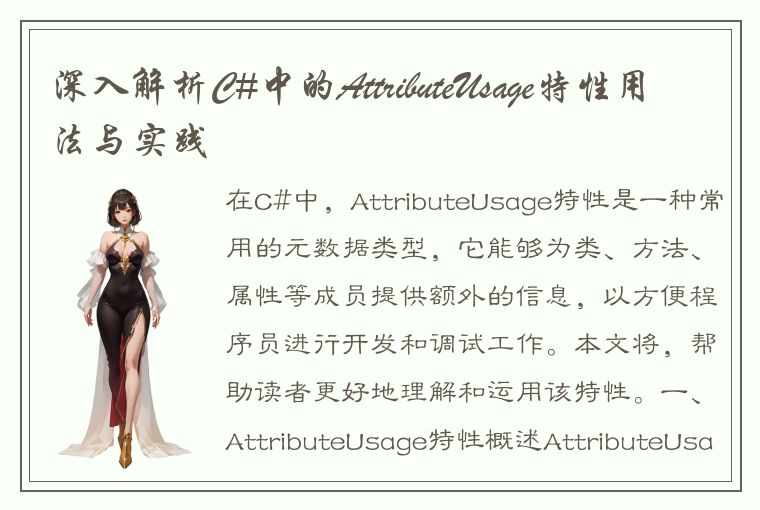在C#中,AttributeUsage特性是一种常用的元数据类型,它能够为类、方法、属性等成员提供额外的信息,以方便程序员进行开发和调试工作。本文将,帮助读者更好地理解和运用该特性。

一、AttributeUsage特性概述
AttributeUsage特性用于定义自定义特性(即Attribute)的使用方式。在定义自定义特性时,我们需要为其指定一个AttributeUsage特性来限定其使用范围。AttributeUsage特性有三个参数:
1. ValidOn:表示该特性可以应用到哪些程序元素上,如类、方法、属性等。
2. AllowMultiple:表示该特性是否允许应用到同一程序元素上多次。
3. Inherited:表示当一个类继承了一个标记了特定特性的基类时,该特性是否传递到派生类中。
二、AttributeUsage特性使用方式
在C#中,我们可以通过以下方式来使用AttributeUsage特性:
1. 声明自定义特性时,通过AttributeUsage特性来指定自定义特性的使用方式。
比如,定义一个自定义特性时,我们可以这样写:
[AttributeUsage(AttributeTargets.Class, AllowMultiple = false, Inherited = true)]
public class CustomAttribute : Attribute
{
//...
}
这里,我们指定该自定义特性只能应用到类上,不能应用到同一类上多次,当一个类继承自另一个标记了CustomAttribute特性的类时,该特性会被传递到其派生类中。
2. 在程序中应用自定义特性时,需符合AttributeUsage特性指定的使用方式。
比如,应用一个定义为切面(Aspect)的自定义特性时,我们可以这样写:
[CustomAspect]
public void MethodA()
{
//...
}
这里,我们将切面特性应用到MethodA方法上,符合AttributeUsage特性中指定的使用范围。
三、AttributeUsage特性相关应用实践
1. 自定义特性类的设计
在定义自定义特性时,应该考虑到其所应用程序元素的特点,合理设计CustomAttribute类的属性和方法,以方便程序员使用和理解。
比如,我们定义一个CustomAuthorizeAttribute特性,该特性用于标记需要登录才能访问的控制器类或者Action方法,并可以传递角色信息。
定义如下:
[AttributeUsage(AttributeTargets.Method | AttributeTargets.Class, AllowMultiple = false, Inherited = true)]
public class CustomAuthorizeAttribute : Attribute
{
public string[] Roles { get; set; }
public CustomAuthorizeAttribute()
{
}
public CustomAuthorizeAttribute(string[] roles)
{
Roles = roles;
}
}
该特性可应用到控制器类或者Action方法上,Roles属性用于传递角色信息。
2. 自定义特性的使用方法
在应用自定义特性时,应该注意其使用方法,避免引发不必要的错误或异常。
比如,应用CustomAuthorizeAttribute特性时,我们可以这样写:
[CustomAuthorize(Roles = new string[] { "Admin" })]
public class HomeController : Controller
{
public ActionResult Index()
{
return View();
}
}
这里,我们将CustomAuthorizeAttribute特性应用到HomeController控制器类上,并传递了角色信息。
3. 自定义特性内部实现
在自定义特性内部的实现过程中,我们应该充分考虑AttributeUsage特性的约束条件,保证程序运行的正确性和稳定性。
比如,在CustomAuthorizeAttribute特性中,我们可以实现如下逻辑:
public class CustomAuthorizeAttribute : Attribute
{
public string[] Roles { get; set; }
public CustomAuthorizeAttribute()
{
}
public CustomAuthorizeAttribute(string[] roles)
{
Roles = roles;
}
public virtual bool IsAuthorized(HttpContextBase httpContext)
{
if (httpContext == null) throw new ArgumentNullException("httpContext");
if (Roles == null || Roles.Length == 0) return true;
if (httpContext.User == null || !httpContext.User.Identity.IsAuthenticated) return false;
foreach (string role in Roles)
{
if (httpContext.User.IsInRole(role)) return true;
}
return false;
}
}
这里,我们判断用户是否登录以及是否具有指定的角色,满足条件则返回true,否则返回false。
四、小结
AttributeUsage特性在C#中是一种常用的元数据类型,它可以为程序员提供额外的信息,方便开发和调试工作。在使用时,我们需要注意指定使用方式,设计自定义特性类的属性和方法,以及遵循约束条件实现内部逻辑。希望本文能够帮助读者更好地理解和运用AttributeUsage特性,促进程序开发与维护工作的高效进行。




 QQ客服专员
QQ客服专员 电话客服专员
电话客服专员